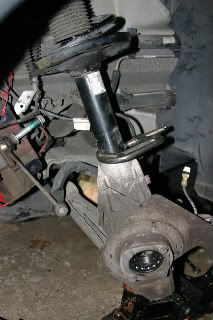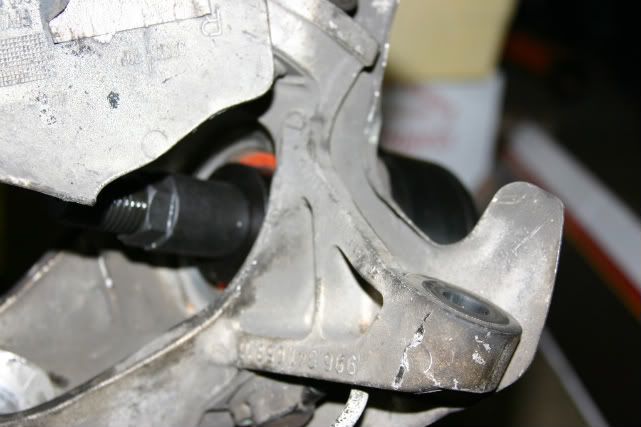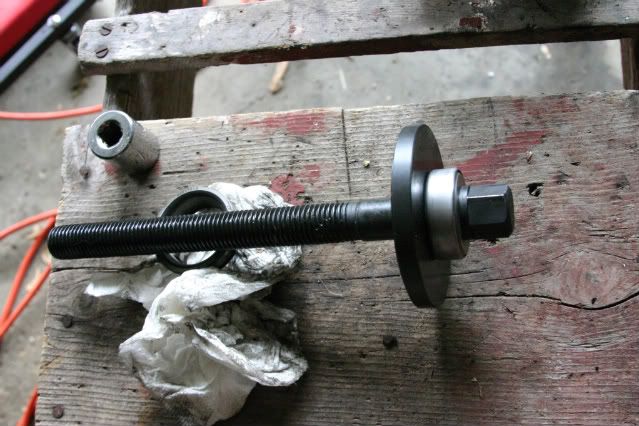 06-08-2011, 07:30 PM
06-08-2011, 07:30 PM
|
#1
|
|
Registered User
Join Date: Mar 2007
Location: Ohio
Posts: 2,031
|
Actually, when the most recent pics were taken, I had already removed the bolt that holds the control arm to the subframe. (Just loosening it really didn't seem to do much.)
On control arm terminology I sometimes get a little screwed up, so I guess I'll go with what Bentley says: "transverse" being the one that is perpendicular to the long axis of the car, ie the one with the ball joint at the bottom of the wheel carrier. "Diagonal" is the other, the one that bolts onto the center of the transverse.
I think you're right, Tom, I think it is the diagonal portion of the control arm that is holding things up. You both recommended I remove the bolt that holds the two parts together (ie "next to the nickel") and that makes sense to me. Insite, you recommended I do that BEFORE I separate the control arm from the subframe. I assume you mean before I remove the bolt holding the transverse control arm (not the diagonal) to the subframe, right? If so, as I indicated above, it's too late for that.
What's the problem that you run into doing it after instead of before? Is it just tougher to wrestle the two arms apart from each other? I could probably put the jack under the inner end (where the bolt has already come out) and lift it back up to approximately where it was.
If you're reading between the lines here you may have already accurately concluded I got NOTHING done on this today, other than reading your suggestions. It was a really tough, really long day at work---I got home just too bushed to even think about working in the garage. The fact that it was like 90 out didn't help matters...
|

|

|
 06-09-2011, 04:48 AM
06-09-2011, 04:48 AM
|
#2
|
|
Registered User
Join Date: Sep 2004
Location: Atlanta
Posts: 1,820
|
i looked at my car in the air yesterday; my coilovers don't block access to the ABS stator. sorry for the misinormation early on!
|

|

|
 06-09-2011, 09:54 PM
06-09-2011, 09:54 PM
|
#3
|
|
Registered User
Join Date: Mar 2007
Location: Ohio
Posts: 2,031
|
Okay, if anybody's still keeping track of this, my progress:

Got the hub pushed out, breaking up the bearing in the process. Doesn't look too bad, but I haven't looked too closely yet. (Hopefully it IS the source of my noise!)

As another member here (JFP) once remarked, by the time you get to the point where you can use the SIR, you're a connection or two away from having the whole wheel bearing carrier off...at which point, you could remove it and take it to a machine shop to do the pressings. However, like I said before, I wanted to be able to do everything in my very own garage. So far, the SIR is working like a charm. It's so agreeable to be able to use a tool that does exactly what it's designed to do, with not a lot of effort, without having to jury-rig anything.
I ended up uncoupling the bolts of the control arms (diagonal and transverse). (I figured out why Insite recommended loosening the bolt that holds the two together, at the middle of the transverse BEFORE removing the bolt that holds the transverse to the subframe: Once the subframe bolt is removed, you can no longer crank on the bolt in the middle (and it's on pretty tight), because the whole thing moves around too much. Are those (the ends of both parts of the control arm) going to be a bear to get back into place in the subframe?? Guess I'll find out...
I've noticed in some of the DIY write-ups recommendations against reusing some of the bolts in reassembling certain suspension components. By kid calls BS, but I was curious what some people here thought. For those of you who have taken apart suspension, brake calipers, etc, have you re-used all the nuts and bolts? If not, which specific ones should one use new ones on? Wouldn't slapping a little Loctite on accomplish the desired result?
|

|

|
 06-11-2011, 02:24 PM
06-11-2011, 02:24 PM
|
#4
|
|
Registered User
Join Date: Mar 2007
Location: Ohio
Posts: 2,031
|
Who's used the SIR tool?
For anyone who's used the SIR tool (or anyone who just happens to know), is this the correct set-up for pushing the bearing out? That's a 14" breaker bar and I'm pretty much putting my whole weight (175 lb) on it to get it to turn even a little. Should it be that tough?


|

|

|
 06-11-2011, 02:48 PM
06-11-2011, 02:48 PM
|
#5
|
|
Registered User
Join Date: Feb 2005
Location: It's a kind of magic.....
Posts: 6,655
|
Looks right.......

Assuming you have lubed the theaded sections of the tool, it should require some effort to get it started, then release and come out. Normally, I would use an impact wrench to get it moving.
__________________
“Anything really new is invented only in one’s youth. Later, one becomes more experienced, more famous – and more stupid.” - Albert Einstein
Last edited by JFP in PA; 06-11-2011 at 02:51 PM.
|

|

|
 06-11-2011, 06:49 PM
06-11-2011, 06:49 PM
|
#6
|
|
Registered User
Join Date: Feb 2005
Location: It's a kind of magic.....
Posts: 6,655
|
I was checking back on your post to see how you made out when I noticed something in your second picture; is that exactly how the tool is set up when you encountered the resistance? Reason I ask is that I just notice the center bolt in your pic is protruding out quite a bit (the large silver thrust wash is not in contact with the tool’s cup face as it is in my photo and the one below). If that is the case, something is not set correctly and you should disassemble the tool and reset it so that the thrust washer is up against the tool when you start to tighten it; that may help with your issue…….

__________________
“Anything really new is invented only in one’s youth. Later, one becomes more experienced, more famous – and more stupid.” - Albert Einstein
|

|

|
 06-11-2011, 08:02 PM
06-11-2011, 08:02 PM
|
#7
|
|
Registered User
Join Date: Mar 2007
Location: Ohio
Posts: 2,031
|
Too late...the task is accomplished and (probably) the damage is done. I noticed when I set it up: the piece you referred to (they call it the "Support Disc #5") would slide past the threads of the big bolt, but then butted up against a narrow lip that was the beginning of the thread-less shaft. That's why, in the second pic of my last post, you can see like 1 1/2" of shaft between the narrow support disc (black) and the thrust bearing (silver colored).
I cranked the hell out of the thing (adding a piece of pipe into the mix---making my breaker bar 2' long or better. Leverage is a wonderful and dangerous thing, ain't it?  ). It turned, but only with A LOT of effort. I kept stopping, removing the crescent wrench (the stopper, on the inside bolt head), looking for progress on bearing movement, oddly never really seeing any. I hadn't gotten far before I realized that it was the 1 1/2" gap that was compressing, the bearing itself not moving a whit. At that point I realized something was not right but figured I was more or less committed---any damage done to the support disc was done, and wasn't going to get any worse by my continued effort. AND, once that 1 1/2" gap disappeared altogether and the support disc contacted the thrust bearing, something else had to start moving, presumably the bearing. That proved to be true, and ultimately the bearing came out cleanly.
Now, however, I have the support disc semi-permanently wedged onto the bolt against the thrust bearing:

It IS tight. I might be able to carefully beat it out with a hammer (buffered with a block of wood), but may just leave it for now until it becomes apparent I even need to get it off. As far as I can tell, I may in fact not need to do that, may still be able to use the tool as is. But I definitely could be wrong about that...time will tell. (My peanut brain can't think that far ahead!)
In all honesty, I don't know what went wrong. The support disc was oriented right, because it had a thin lip that fit nicely into the next piece (the wide spacer sleeve). It just seemed like the hole in the center was not quite as big as it should have been.
Oh well, onto the next step...
|

|

|
 Posting Rules
Posting Rules
|
You may not post new threads
You may not post replies
You may not post attachments
You may not edit your posts
HTML code is On
|
|
|
All times are GMT -8. The time now is 04:56 AM.
| |